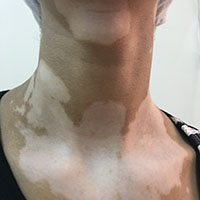Soluble CD27 and MIF as possible serum biomarkers of vitiligo activity in Egyptian patients in Sharkia Governorate

Accepted: 30 October 2019
HTML: 30
All claims expressed in this article are solely those of the authors and do not necessarily represent those of their affiliated organizations, or those of the publisher, the editors and the reviewers. Any product that may be evaluated in this article or claim that may be made by its manufacturer is not guaranteed or endorsed by the publisher.
Contrary to other inflammatory skin disorders like psoriasis or atopic dermatitis, vitiligo does not present with distinct inflammatory symptoms that can be easily evaluated by clinical examination. Identification of a putative biomarker to inform early and accurate treatment responses could be of considerable value. This study aims to validate levels of serum soluble CD27 (sCD27) and macrophage Migration Inhibitory Factor (MIF) as biomarkers of vitiligo to improve the quality of disease management. This cross-sectional study was conducted on 32 vitiligo patients, stratified into two subgroups of 22 active and 10 stable vitiligo patients; the stable group containing 1 segmental and 9 non-segmental presentations, and 32 matched healthy individuals as the control group. Of the 32 patients in the study, 21 were female and 11 were male with a median age of 30 years. The measurements of the study parameters of sCD27 and MIF in the serum were carried out through blood sampling and followed up for three months at one-month intervals for stable vitiligo cases. Mean serum levels of sCD27 and MIF were significantly higher in vitiligo patients than in the control group. A positive correlation was observed in active vitiligo cases between both serum MIF and sCD27 levels and the spreading item of Vitiligo European Task Force (VETF) score as an indicator of disease activity. Serum sCD27 and MIF levels in vitiligo patients were observed to be higher than that of controls with greater correlation found for sCD27 with disease activity.
PAGEPress has chosen to apply the Creative Commons Attribution NonCommercial 4.0 International License (CC BY-NC 4.0) to all manuscripts to be published.





 https://doi.org/10.4081/dr.2019.8265
https://doi.org/10.4081/dr.2019.8265



